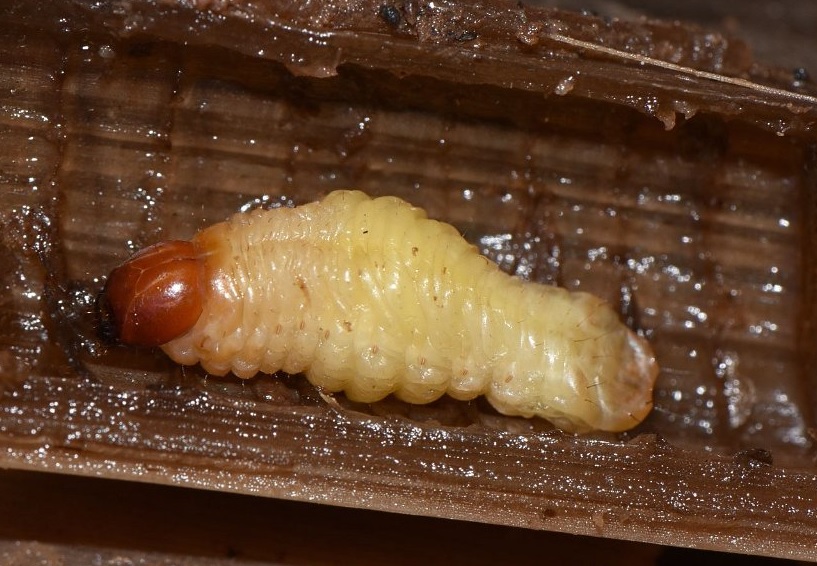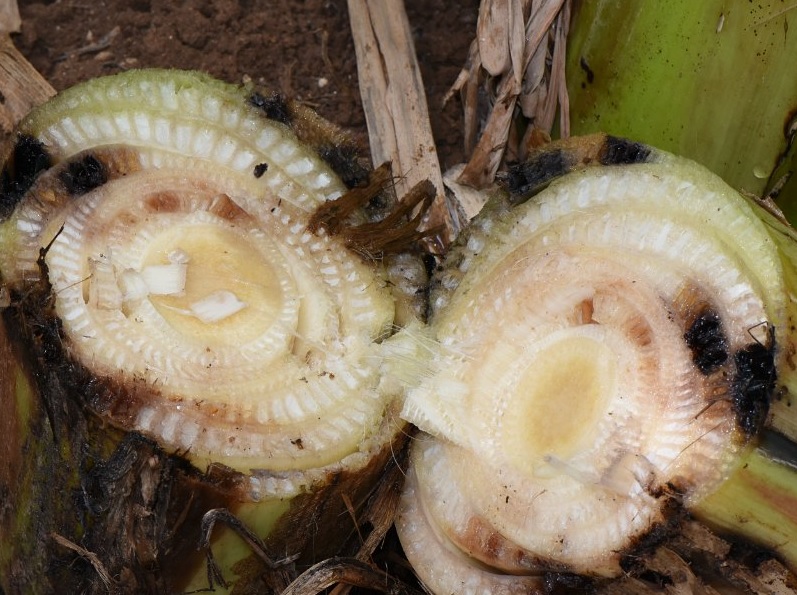Catalogue of traps and pheromones
Download traps and pheromones list

Download document
1.02 mb
The banana stem weevil is one of the most important pests of bananas and plantains.

The weevils are predominantly nocturnal in habit, although during cloudy days and cooler months they may fly during the daytime. They often confine themselves within the pseudostem and in the decomposing tissues of harvested pseudostems. All life stages of the weevil are present throughout the year in the infested plant. Adults are strong fliers and in this way, move from plant to plant. The banana stem weevil has a long life span and many adults live for a year. The sex ratio of adults encountered in banana gardens is 1:1.17 (male:female).

The pre-oviposition period is 15-30 days and the adult weevils mate throughout the day and night. The mean number of eggs laid by a female following a single mating is nine eggs at the rate of one egg per day. Gravid females lay yellowish white, elliptical eggs by inserting the ovipositors through ovipositional slits cut by the rostrum on the outer epidermal layer of the leaf sheath of the pseudostem down to the air chambers. Oviposition takes place only in the leaf sheaths.
The incubation period ranges from 3 to 8 days. The larvae feed on tissues of the succulent sheath by tunnelling extensively and may reach as far as the stem. If larvae emerge during the advanced pre-flowering stage of the plant, the ascending flower bud and the peduncle inside the pseudostem can be eaten and damaged, resulting in non emergence of the flower bud which decays inside the pseudostem In severely infested plantations, more than 20% plants do not flower due to this reason. The depth of the tunnels made by the larvae range between 8 to 10 cm. The tunnels are widespread and may go as high as the fruit peduncle or to the lowermost collar region near the rhizome. The larvae pass through five instars. The fifth instar larvae enters a non-feeding pre-pupal stage and constructs a cocoon by winding short pieces of fibrous materials of the sheath around its body. The developmental rates are highly dependent on climatic factors with the duration of the life stages longer in the winter season than in the summer.

Adult Banana borer are attracted by the volatiles released by the banana plants. Infestation of the weevil normally starts in 5-month-old plants. Early symptoms of the infestation are the presence of small pinhead-sized holes on the stem, fibrous extrusions from bases of leaf petioles, adult weevils and exudation of a gummy substance from the holes on the pseudostem. During the advanced stages of infestation, the stem, when split open, exhibits extensive tunnelling both in the leaf sheath and in the true stem. When the true stem and peduncle are tunnelled after flowering, the fruits do not develop properly.

Weakening of the stem by larval tunnelling may result in breakage by wind or inability to bear the weight of the maturing bunch. It is estimated that the stem weevil causes 10-90% yield loss depending on the growth stage of the crop.

This insect is found in India, China, Malaysia, Indonesia and Thailand and is a key pest of bananas and plantains, posing a great threat to banana production systems in these countries.
Cultural control
Field sanitation is imperative in the control of this pest. Dried old leaves must be removed to allow the detection of early symptoms of weevil infestation and to increase the efficacy of pheromone trap. Suckers (plant vertical growth coming from the roots or lower main stem of a plant) should be pruned periodically and infested pseudostems must be removed from the field and destroyed. Banana stumps (the lower end of plant left after the main part falls or is cut off) kept in the field after harvest must be removed and destroyed as they serve as weevil refuges and breeding sites. Investigations made at the National Research Centre for Banana (NRCB) have indicated that traps could be efficiently used to monitor and reduce the adult weevil population.
Proper use of Pheromone Traps:
The pheromone trap is designed to monitor and reduce pest numbers. In order to determine the population density of pest insects and to identify pest outbreaks (monitoring), it is recommended to use 1 trap per 1 ha.
The trap should be placed in the crown of the tree at a height of 1.5-2 m. Prior to the first flight of the weevils, the traps must be checked on a daily basis, and after the first weevils have been captured, the traps must be checked every 5-7 days. Protective measures are based on the results of the monitoring of population density of pest insects.
Trap placement:
For mass capture and sterilization of males, it is recommended to have more than 20 traps per hectare. In case of a large number of pest insects use 30 traps per 1 ha.
Download traps and pheromones list

1.02 mb
Review our catalogue of pheromons and semiochemicals by chemical name

525.1 kb